ONLY ZERO CARBON ONLY ZERO CARBON ONLY ZERO CARBON ON LY ZERO CARBON ONLY ZERO CARBON ONLY ZERO
The published science is in agreement on what it takes to stabilize atmospheric CO2 long term. It is the virtually total cessation of all human carbon emissions. Virtual zero is the closest we can get to zero and will be about a 90% reduction of today's emissions. That means stopping emissions.
These are the two fundamental (should be obvious) essentials of global climate change mitigation and our survival. Stop putting carbon into the air and start taking carbon out of the air. We can do both by a number of ways.
However of emissions are not peaked (to decline) by 2020 negative emissions will be required and the longer the delay in peaking the more CO2 would have to be removed.
Removal of tens of Gtons of CO2 per year is not feasible and it would have to be continued for hundreds of years.
The environmental movement is understandably opposed to the very idea of extracting carbon direct from the air on the basis it is geo-engineering or it will make individual behavior change less likely. The fact of the science is that zero carbon will have to include include a capacity for negative carbon if required in the future.
However of emissions are not peaked (to decline) by 2020 negative emissions will be required and the longer the delay in peaking the more CO2 would have to be removed.
Removal of tens of Gtons of CO2 per year is not feasible and it would have to be continued for hundreds of years.
The environmental movement is understandably opposed to the very idea of extracting carbon direct from the air on the basis it is geo-engineering or it will make individual behavior change less likely. The fact of the science is that zero carbon will have to include include a capacity for negative carbon if required in the future.
It was established by the science many years ago that atmospheric CO2 concentration could not fall unless CO2 emissions stopped. The latest IPCC assessment said that the long term atmospheric CO2 could not be stabilized without stopping emissions.
It has been known for may years that all the world's energy needs can be met by zero carbon (alternate renewable) energies. In fact zero carbon energy potential is many times than all the fossil fuels being burned.
2. Start increasing the Earth ncarbon cycle's capacity to take and store carbon from the atmosphere
Agricultural conversion to organic regenerative farming
(like permaculture) or agro-forestry is the first essential, doing both of the above.
Nature Journal October 2009 Climate Cruch Sucking It Up.
www.nature.com/news/2009/090429/full/4581094a.html
Caution is warranted in taking values as targets for decision-making.
Atmospheric CO2 concentrations are currently at 390 p.p.m., and even if we could put an end to our emissions now, a sizable fraction of CO2 would remain in the atmosphere for millennia (Nat. Rep. Clim. Change 2, 156–158; 2008). Unless we find a way of sucking CO2 out of the atmosphere (Science 325, 1654–1655; 2009), returning to 350 p.p.m. within a time-frame that is relevant to decision-makers will be well high impossible.
Targets can all too easily be used to justify continued environmental degradation on the basis that it is within an acceptable range (Nature 461, 447–448; 2009). That's especially true of long-term goals, whose chances of being met can't be measured by present-day behaviour.
www.nature.com/news/2009/090429/full/4581094a.html
Caution is warranted in taking values as targets for decision-making.
Atmospheric CO2 concentrations are currently at 390 p.p.m., and even if we could put an end to our emissions now, a sizable fraction of CO2 would remain in the atmosphere for millennia (Nat. Rep. Clim. Change 2, 156–158; 2008). Unless we find a way of sucking CO2 out of the atmosphere (Science 325, 1654–1655; 2009), returning to 350 p.p.m. within a time-frame that is relevant to decision-makers will be well high impossible.
Targets can all too easily be used to justify continued environmental degradation on the basis that it is within an acceptable range (Nature 461, 447–448; 2009). That's especially true of long-term goals, whose chances of being met can't be measured by present-day behaviour.
To have any chance of stopping global warming from increasing nations must plan to stop the emissions of all long lasting (in the atmospshere) greenhouse gases- confirmed by IPCC 2014 AR5. This is not impossible, it does not mean the end of civilization (global climate change does). That's because it is just a matter of switching technologies and chemicals to zero carbon and non toxic alternatives that exist already.
We are told that to reduce emissions would be very costly. This is the biggest climate change lie out there and most people have fallen for it.
It would not cost anything. The truth is developing any new technology is a huge economic boost.
The global zero carbon development and re-development would be the greatest economic and employment boost ever.
There is in addition a huge immediate cost saving from stopping the toxic air and water pollution of fossil fuels. The cost to our health and from health treatment is enormous.
We are told that to reduce emissions would be very costly. This is the biggest climate change lie out there and most people have fallen for it.
It would not cost anything. The truth is developing any new technology is a huge economic boost.
The global zero carbon development and re-development would be the greatest economic and employment boost ever.
There is in addition a huge immediate cost saving from stopping the toxic air and water pollution of fossil fuels. The cost to our health and from health treatment is enormous.
Amongst scientists who have publicly recommended a zero carbon response for years to the public are Bill Hare and Hans Schellnhuber of the Potsdam Climate Institute (German). They are both top long-standing climate change experts. (See report and the 1C graph below and click image for the World watch State of the World 2009 on climate change by Bill Hare). Please note anything higher than 1C is not safe and is disastrous for billions of the most climate change vulnerable with respect to terrible losses of their water food and health.
IMF 2013 World fossil fuel subsides $1.9 trillion
De-carbonisation is impossible without stopping all fossil fuel subsidies.
De-carbonisation is impossible without stopping all fossil fuel subsidies.
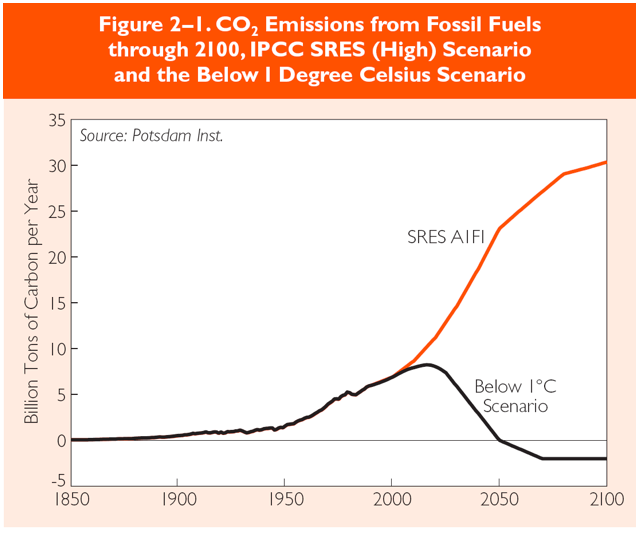
Zero Carbon Science to Zero Carbon Response

Decarbonisation
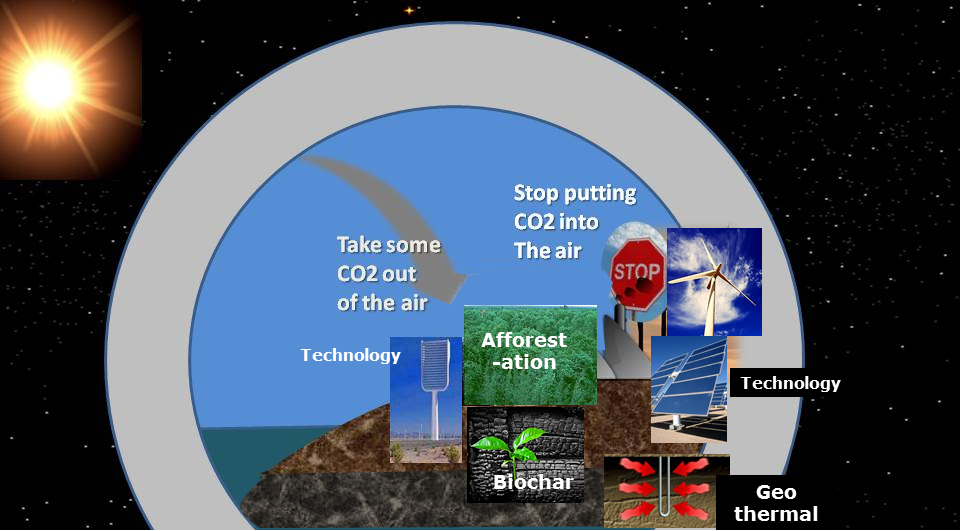
Fossil fuel energy intensity Decarbonisation is too often understood today to mean reducing fossil fuel energy intensity, that is burning fossil fuels more efficiently which is assumed to be on the way to a 'low' carbon economy.
This is absolutely not what decarbonization is according to the climate system science- that demands zero carbon emissions.
Using energy more efficiently is most important, but we have to totally convert our energy supply so that we don't burn any fossil fuels for energy.
In fact a policy of burning fossil fuels more efficiently but not based on replacing all fossil fuel energy allows the continued globalization of fossil fuel energy and hence the continued escalation of carbon emissions.
This is absolutely not what decarbonization is according to the climate system science- that demands zero carbon emissions.
Using energy more efficiently is most important, but we have to totally convert our energy supply so that we don't burn any fossil fuels for energy.
In fact a policy of burning fossil fuels more efficiently but not based on replacing all fossil fuel energy allows the continued globalization of fossil fuel energy and hence the continued escalation of carbon emissions.
The various methods to stop adding carbon and start subtracting carbon.
Best efficiency is essential for all methods but energy efficiency alone can never
get anywhere close to zero carbon.
Obviously to reach zero carbon the world wide clean energy infrastructure (hardware) has to be manufactured with zero carbon energy. This requires a vast amount of zero carbon high energy dense power, which at the present our clean energy renewable sources cannot provide as they are low energy dense.
The only zero carbon options are forms of nuclear energy.
Energy density importancefrom IPCC 2012 Renewable Energy report.
With atmospheric CO2 now above 400 ppm and climbing fast
Best efficiency is essential for all methods but energy efficiency alone can never
get anywhere close to zero carbon.
Obviously to reach zero carbon the world wide clean energy infrastructure (hardware) has to be manufactured with zero carbon energy. This requires a vast amount of zero carbon high energy dense power, which at the present our clean energy renewable sources cannot provide as they are low energy dense.
The only zero carbon options are forms of nuclear energy.
Energy density importancefrom IPCC 2012 Renewable Energy report.
With atmospheric CO2 now above 400 ppm and climbing fast
Research News
June 2016 IRENA The Power to Change: Solar and Wind Cost Reduction Potential to 2025
15 April 2016 Fossil fuels could be phased out worldwide in a decade, says new study
March 2016 UNEP renewable trends
3 Aug 2015 Sucking carbon from the sky may do little to slow climate change and is no help for rapidly increasing ocean acidification and de-oxygenation.
June 2015 CAN Int. Missed benefits, Quantifying potential co-benefits.
June 29015 OXFAM
Why the G7 must stop burning coal to tackle climate change and fight hunger
March 2015 the worlds worst coal plants- Stranded Assets report.
March 2015 Bank report: Oil cannot match solar now
March 2015 US CCS Futuregen demo project for coal project terminated, again.
30 Jan 2015 Sc. Am. Nuclear Power Needs to Double to Curb Global Warming
Oct 2014 Nature Natural gas will not help climate
July 2014 Replacing coal and oil with natural gas will not help fight global warming
June 2014 Nothing substitutes for reducing CO2 emissions.
April 2014 IPCC climate change report: averting catastrophe is cheap. replace The cheapest and least risky route to dealing with global warming is to abandon all dirty fossil fuels
April 2014 Science Carbon Storage in Basalt
The cost of carbon capture and storage is dominated by capture and gas separation, which costs $55-$112/ton CO2’. J Matter
2013 Solar photovoltaic can provide 100%
world energy needs with less than 1% of world land
WWF 2013
June 2016 IRENA The Power to Change: Solar and Wind Cost Reduction Potential to 2025
15 April 2016 Fossil fuels could be phased out worldwide in a decade, says new study
March 2016 UNEP renewable trends
3 Aug 2015 Sucking carbon from the sky may do little to slow climate change and is no help for rapidly increasing ocean acidification and de-oxygenation.
June 2015 CAN Int. Missed benefits, Quantifying potential co-benefits.
June 29015 OXFAM
Why the G7 must stop burning coal to tackle climate change and fight hunger
March 2015 the worlds worst coal plants- Stranded Assets report.
March 2015 Bank report: Oil cannot match solar now
March 2015 US CCS Futuregen demo project for coal project terminated, again.
30 Jan 2015 Sc. Am. Nuclear Power Needs to Double to Curb Global Warming
Oct 2014 Nature Natural gas will not help climate
July 2014 Replacing coal and oil with natural gas will not help fight global warming
June 2014 Nothing substitutes for reducing CO2 emissions.
April 2014 IPCC climate change report: averting catastrophe is cheap. replace The cheapest and least risky route to dealing with global warming is to abandon all dirty fossil fuels
April 2014 Science Carbon Storage in Basalt
The cost of carbon capture and storage is dominated by capture and gas separation, which costs $55-$112/ton CO2’. J Matter
2013 Solar photovoltaic can provide 100%
world energy needs with less than 1% of world land
WWF 2013
This is promoted by science and government as a way to achieve atmospheric CO2 stabilization. It is not. This industry cannot be allowed because with it we will not achieve zero carbon. Its promotion relies on assumed big success of carbon capture and storage (CCS). CCS is a failure despite large public investment. It cannot possibly work for much carbon or for long. Burning any small scale biomass only recycles biomass carbon, that has been stored by green plants, faster back to the atmosphere -than if the biomass had been left. An EU study looking into how effective carbon neutral wood energy would be, was surprised to find that felling trees emitted a lot of CO2 fast by disturbing the forest floor high carbon content letter. All things considered on carbon- the trees are best left alone.
Burning trees and plants to mitigate climate change is the worst idea possible.
So burning wood or other biomass for heat or cooking has to stop to achieve zero carbon. These CO2 sources also include black carbon (soot) which has been found to be second only to CO2 as a source of global warming emissions.
Geo-engineering carbon
Though it has always been necessary to draw down some CO2 from the air to achieve zero carbon, geo-engineering for CO2 removal cannot in any way prevent or delay planetary catastrophe without emergency conversion of all industrial fossil fuel energy to clean zero carbon energy. 2015 research finds it does not offer any remedy for the rapidly increasing ocean acidification and de-oxygenation from industrial CO2 emissions. A 2015 NAP long report does not find any feasible mehtod outside of the natural carbon cycle to remove the large amounts of CO2 for 1000s of years (that would be needed with continued fossil fuel emissions on the horizon.
How are we doing on decarbonization?
Very badly. A 2012 Price Waterhouse Cooper analysis says we are headed for 6C by 2100 and that the decarbonisation rate required for a 2°C world has not been achieved in a single year since World War 2. (Note the 2C policy target is certain catastrophe.)
How fast can the world decarbonize?
Nearly all science sources give a minimum of 50 years.
The best case IPCC scenario (RCP 2.6) is over 50 years.
The best published is 25 years illustrated by
Clean Air Task Force literature review 2011 (image opposite).
But most studies assume a 50 year time frame at the least,
like the October 2013 report which concluded- while more research is
needed, existing scenarios show that it is technically and economically feasible
to reduce emissions to zero for roughly 90% of current sources of GHG emissions
with technological options that are available today and in the near future,
by Ecofys Feasibility of GHG emissions phase-out by mid-century
Burning trees and plants to mitigate climate change is the worst idea possible.
So burning wood or other biomass for heat or cooking has to stop to achieve zero carbon. These CO2 sources also include black carbon (soot) which has been found to be second only to CO2 as a source of global warming emissions.
Geo-engineering carbon
Though it has always been necessary to draw down some CO2 from the air to achieve zero carbon, geo-engineering for CO2 removal cannot in any way prevent or delay planetary catastrophe without emergency conversion of all industrial fossil fuel energy to clean zero carbon energy. 2015 research finds it does not offer any remedy for the rapidly increasing ocean acidification and de-oxygenation from industrial CO2 emissions. A 2015 NAP long report does not find any feasible mehtod outside of the natural carbon cycle to remove the large amounts of CO2 for 1000s of years (that would be needed with continued fossil fuel emissions on the horizon.
How are we doing on decarbonization?
Very badly. A 2012 Price Waterhouse Cooper analysis says we are headed for 6C by 2100 and that the decarbonisation rate required for a 2°C world has not been achieved in a single year since World War 2. (Note the 2C policy target is certain catastrophe.)
How fast can the world decarbonize?
Nearly all science sources give a minimum of 50 years.
The best case IPCC scenario (RCP 2.6) is over 50 years.
The best published is 25 years illustrated by
Clean Air Task Force literature review 2011 (image opposite).
But most studies assume a 50 year time frame at the least,
like the October 2013 report which concluded- while more research is
needed, existing scenarios show that it is technically and economically feasible
to reduce emissions to zero for roughly 90% of current sources of GHG emissions
with technological options that are available today and in the near future,
by Ecofys Feasibility of GHG emissions phase-out by mid-century

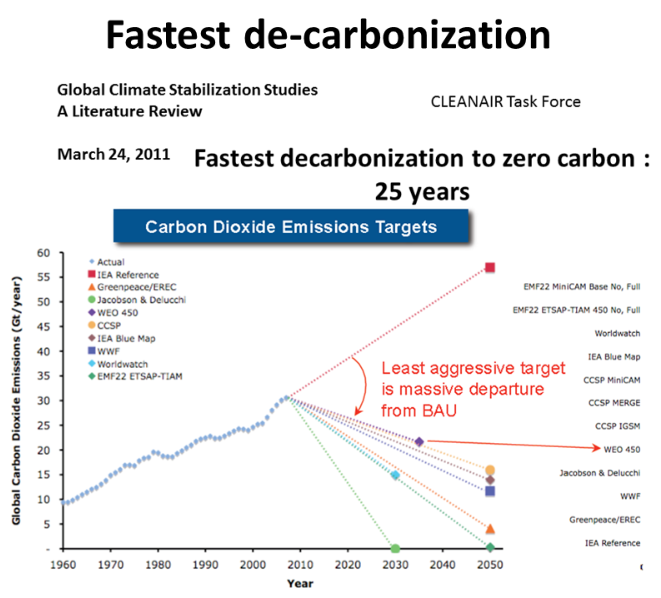
Nov 2013 Overseas Development Institute
The Climate Emergency-
what the carbon budget really means
The Climate Emergency-
what the carbon budget really means
2013 Greenpeace- largest planned fossil fuel projects by 2020. To stop adding moreCO2 to the atmosphere a lot of massive planned fossil fuel projects have to stop.
The world's worst coal fired power plants(Interactive) have to be phased out -closed.
CO2 removal
2015 NRC Climate Intervention:
Carbon Dioxide Removal & Reliable Sequestration (2015 US National Research Council)
This report includes:
As essential to use for zero carbon, it will be required to achieve zero carbon emissions- even with 100% replacement of all fossil fuel energy with renewable energy, because the best we can do is virtual zero or 90-95% reduction of emissions. This is possible but needs a lot of energy on a global scale- that means the most rapid research, development and global deployment (RDD) of non polluting renewable energy.
Fossil fuel carbon capture storage (CCS) = fossil fuel boobdoggle.
29 Mar 2016 NYT SaskPower Technology to Make Clean Energy From Coal Is Stumbling in Practice
26 Oct 2015 Slow SaskPower carbon capture performance costing millions
Feb 2015 US big FutureGen 2.0 has been abandoned because the US cannot afford it. The FutureGen (1.0) project was officially launched by the G.W. Bush administration in 2004 to produce so called clean coal power. It was abandoned because it did not deliver on clean coal and was far too costly even as a US public private partnernhip.
This still appears to be favoured by scientists and governments, because it routinely included in list of options for climate mitigation. How ever it should be no part of mitigation. After decades of R and D it is still unproven, though it is assumed to be a practical proposition. It requires more energy to operate and adds greatly to fossil fuel energy cost. At its theoretical best it could never get us near to zero carbon. It is a deadly idea because it is a boondoggle being used to prolong the use of fossil fuels.
Biomass combustion with CCS.
The world's worst coal fired power plants(Interactive) have to be phased out -closed.
CO2 removal
2015 NRC Climate Intervention:
Carbon Dioxide Removal & Reliable Sequestration (2015 US National Research Council)
This report includes:
- Direct Air Capture (DAC) & utilization/sequestration of CO2.
- Fossil fuel carbon capture storage (CCS)
- Biomass combustion with CCS.
There are only two to safely and surely remove carbon from the atmosphere: biochar and wood construction.
International biochar initiative
Direct Air Capture (DAC) & utilization/sequestration of CO2.
International biochar initiative
As essential to use for zero carbon, it will be required to achieve zero carbon emissions- even with 100% replacement of all fossil fuel energy with renewable energy, because the best we can do is virtual zero or 90-95% reduction of emissions. This is possible but needs a lot of energy on a global scale- that means the most rapid research, development and global deployment (RDD) of non polluting renewable energy.
Fossil fuel carbon capture storage (CCS) = fossil fuel boobdoggle.
29 Mar 2016 NYT SaskPower Technology to Make Clean Energy From Coal Is Stumbling in Practice
26 Oct 2015 Slow SaskPower carbon capture performance costing millions
Feb 2015 US big FutureGen 2.0 has been abandoned because the US cannot afford it. The FutureGen (1.0) project was officially launched by the G.W. Bush administration in 2004 to produce so called clean coal power. It was abandoned because it did not deliver on clean coal and was far too costly even as a US public private partnernhip.
This still appears to be favoured by scientists and governments, because it routinely included in list of options for climate mitigation. How ever it should be no part of mitigation. After decades of R and D it is still unproven, though it is assumed to be a practical proposition. It requires more energy to operate and adds greatly to fossil fuel energy cost. At its theoretical best it could never get us near to zero carbon. It is a deadly idea because it is a boondoggle being used to prolong the use of fossil fuels.
Biomass combustion with CCS.
Pollution charge The surest fastest way to de-carbonize is to charge the full full pollution costs of large emitters, which is inaccurately referred to as a carbon price or tax.
Fossil fuel divestment is a global program started by 350.org proving to be effective in discouraging this most destructive type of investment
Energy storage is required to further increase the fast growing available renewable energy for 24 hour avaiolability.
Fossil fuel divestment is a global program started by 350.org proving to be effective in discouraging this most destructive type of investment
Energy storage is required to further increase the fast growing available renewable energy for 24 hour avaiolability.
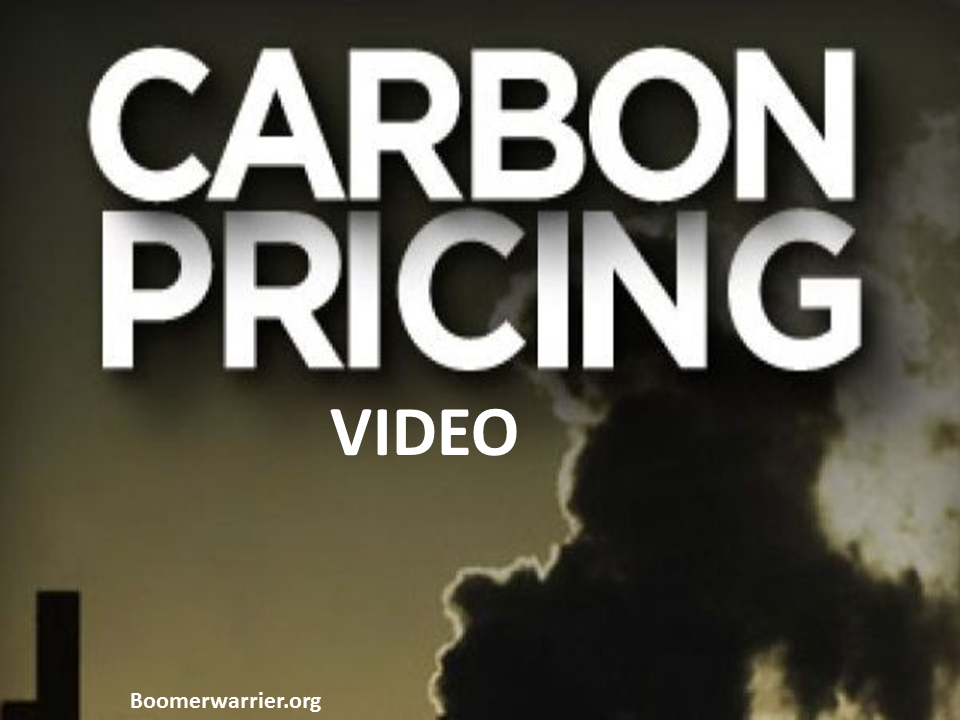
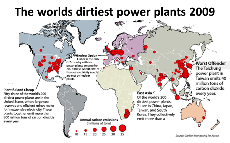
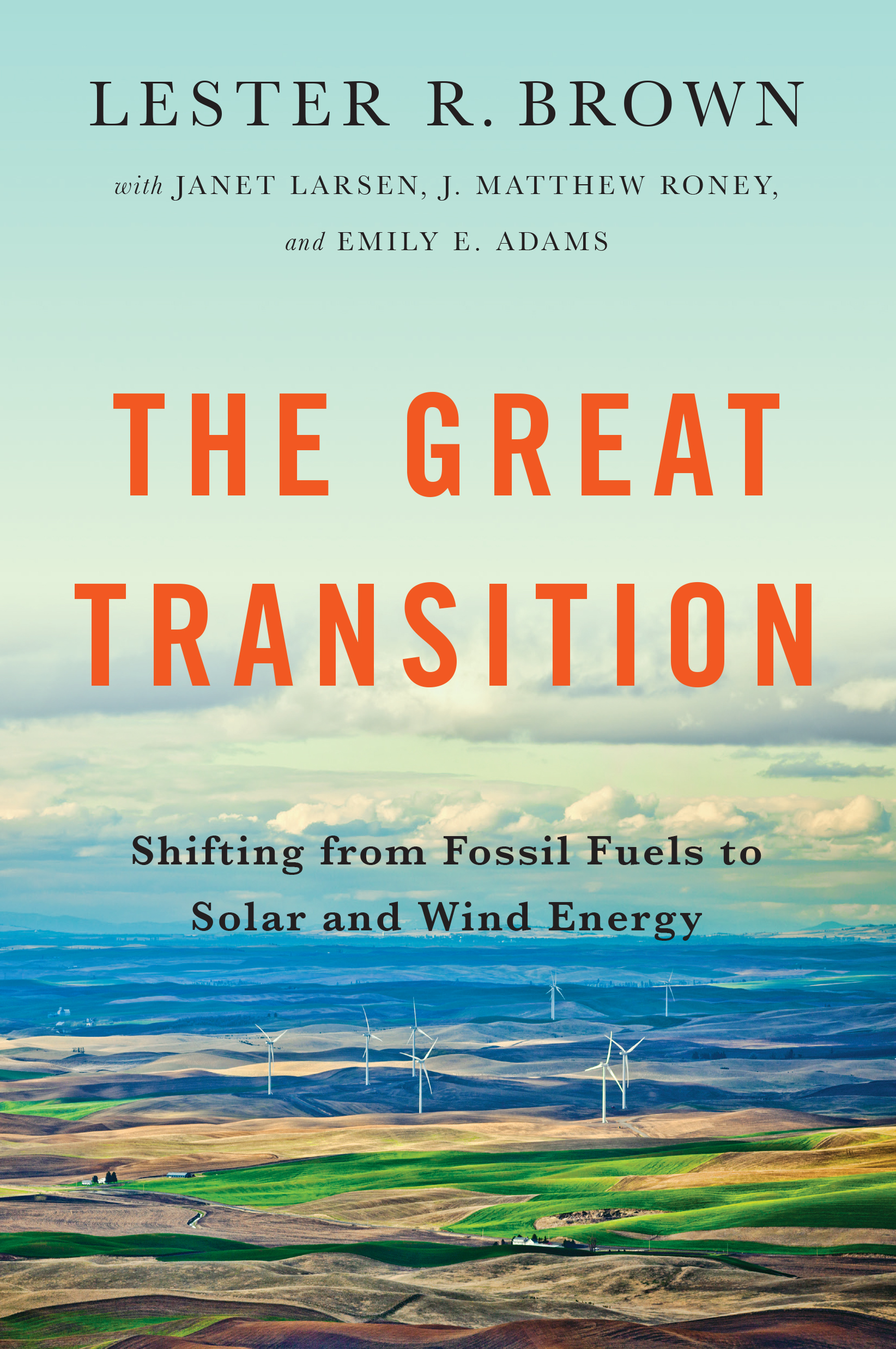
Jeremy Leggett's on-line book The Winning of the Carbon War
Global Apollo program report.
Worldwide, publicly-funded R&D on renewable energy is under
2% of the total of publicly funded research and development – only around $6 billion.
Sept 2015 David Attenborough backs huge Apollo-style clean energy research plan includes VIDEO.
June 2015 Good news! Global Apollo Initiative aims to switch the world to renewable energy.
June 2015 MIT panel backs divestment from coal, tar sand firms
Zero carbon Nuclear used to be a non-issue, but for any chance at this late date of staying under 2C, it is esssential
Worldwide, publicly-funded R&D on renewable energy is under
2% of the total of publicly funded research and development – only around $6 billion.
Sept 2015 David Attenborough backs huge Apollo-style clean energy research plan includes VIDEO.
June 2015 Good news! Global Apollo Initiative aims to switch the world to renewable energy.
June 2015 MIT panel backs divestment from coal, tar sand firms
Zero carbon Nuclear used to be a non-issue, but for any chance at this late date of staying under 2C, it is esssential
June 2015 VIDEO A Fossil Fuel Free World is Possible: How to Power a Warming Earth Without Oil, Coal and Nuclear
6 June 2015
NY Times Case for carbon tax
NY Times Case for carbon tax
Sept 2015 Cities switching off fossil fuel energy
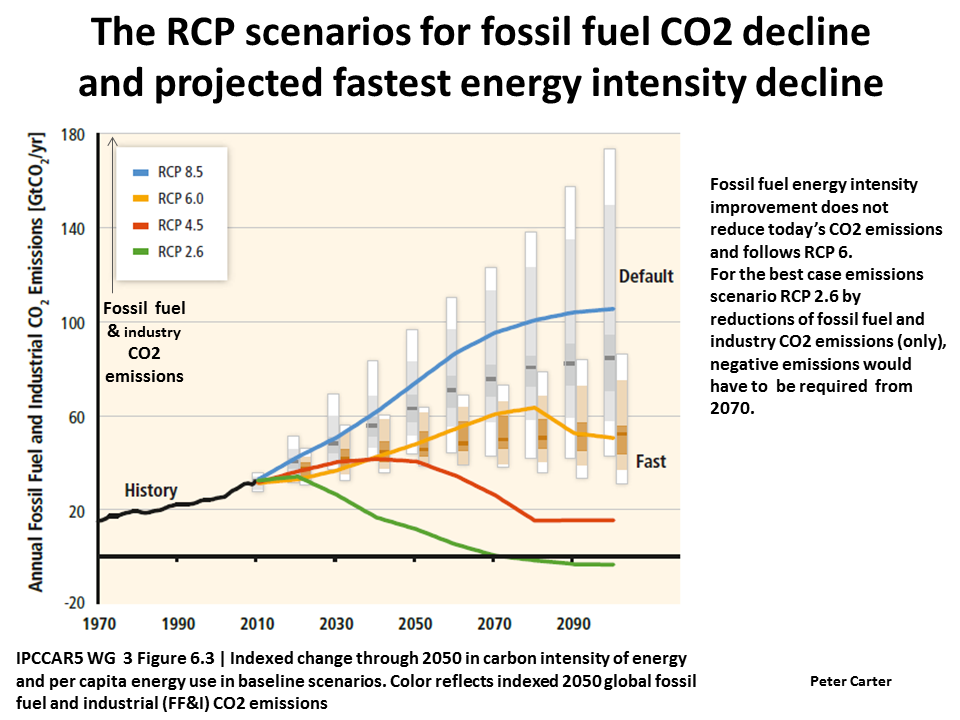

The effect of cutting CO2 emissions to zero by 2050 (T. Wigley)
based on Uncertainties in climate stabilization T. Wigley
based on Uncertainties in climate stabilization T. Wigley
Oct 2014 Ecofys
Feasibility of GHG emissions
phase-out by mid-century
Feasibility of GHG emissions
phase-out by mid-century
The position of global civil society (CAN Int. 2014) is 100% replacement of fossil fuel energy with clean renewable by 2050. That is the only de-carbonization for zero carbon
RENEWABLE ENERGY LIMITS Renewable energy production has been increasing well, but so has fossil fuel energy extraction.
Renewable energy can easily replace all fossil fuel generated electricity, but power for heavy industry and for transportation is another matter. Here high energy density is required and renewables (except for big dam hydro) are far too low on energy density.
Renewable energy is not going to be able to provide the power to manufacture renewable energy energy infrastructure for the zero carbon world.
The only high energy and power density alternatives to fossil fuels are big hydro dams (but they can release methane after some time) and nuclear- fission and potentially fusion.
With continued R&D for renewables their energy density will no doubt be increased, but we can't wait that long and we don't know if the increase would be enough for making metals and heavy manufacturing
Renewable energy can easily replace all fossil fuel generated electricity, but power for heavy industry and for transportation is another matter. Here high energy density is required and renewables (except for big dam hydro) are far too low on energy density.
Renewable energy is not going to be able to provide the power to manufacture renewable energy energy infrastructure for the zero carbon world.
The only high energy and power density alternatives to fossil fuels are big hydro dams (but they can release methane after some time) and nuclear- fission and potentially fusion.
With continued R&D for renewables their energy density will no doubt be increased, but we can't wait that long and we don't know if the increase would be enough for making metals and heavy manufacturing
2015 VIDEO Cold Fusion is Real ! now called LENR
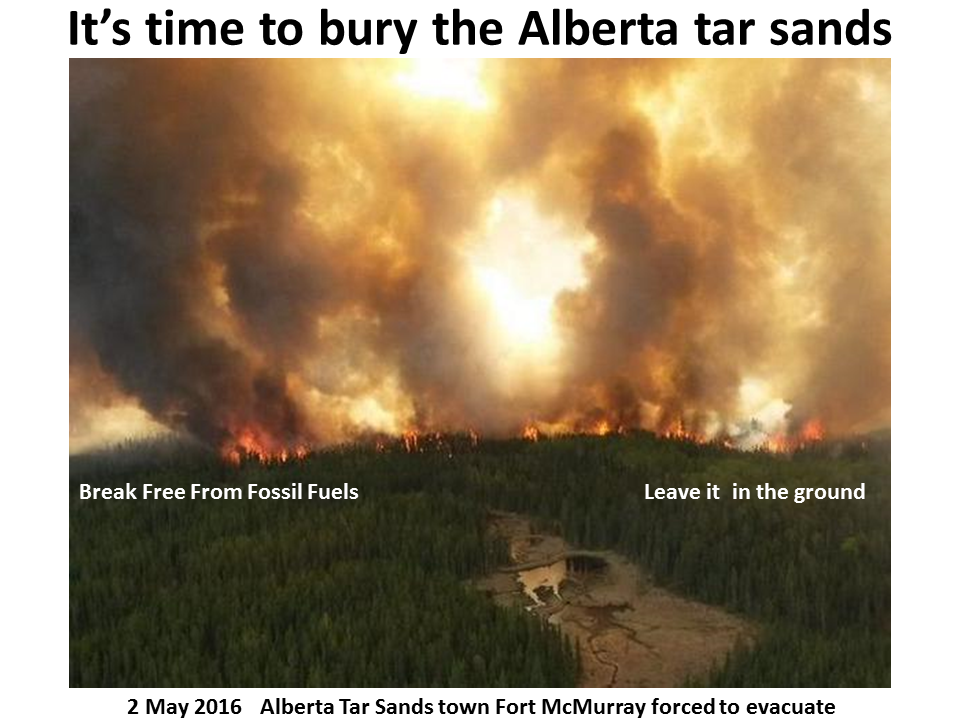
The future (only future), that is totally doable, is with vast amounts of zero carbon high energy dense safe power.
Now and for the foreseeable future it is not possible to get CO2 emissions down to 'near zero' (IPCC 2014 AR5) with clean renewables. Clean renewable energy sources with the exception of deep geothermal and well situated solar thermal (that must be pursued to the maximum), cannot manufacture themselves.
Low Tec Mag solar thermal The bright future of solar thermal powered factories. This is an exclleent article but the solution offered does not get near zero carbon. Only if fossil fuels and biomass (see end of article) are changed to compact nucelar fission would it work.
Low Tec Mag Solar voltaic How Sustainable is PV solar power?
Low Tec Mag solar thermal The bright future of solar thermal powered factories. This is an exclleent article but the solution offered does not get near zero carbon. Only if fossil fuels and biomass (see end of article) are changed to compact nucelar fission would it work.
Low Tec Mag Solar voltaic How Sustainable is PV solar power?